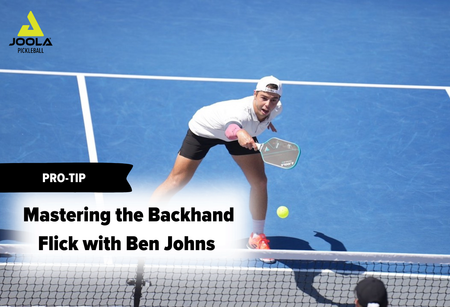
Mastering the Backhand Roll in Pickleball: Tips from Ben Johns
The backhand roll is a crucial and exciting shot in pickleball, and no one demonstrates its power and finesse better than Ben Johns. With seven years of experience perfecting this shot, Johns offers a detailed guide to help players at all levels incorporate it into their game. Here’s a breakdown of his tips on how to hit an effective backhand roll:

1. Drilling Set-Up:
Before diving into the mechanics, Johns emphasizes the importance of a proper drill setup:
- Partner drill: Position your partner to hit cross-court dinks to your backhand side. The aim is to hit the ball out of the air from below the net level.
- Focus on taking balls out of the air: The backhand roll is not meant to be hit off the bounce. Ensure you’re practicing hitting the ball before it lands.
2. Key Elements to Watch For:
Johns highlights several critical elements to keep in mind:
- Avoid excessive wrist use: Contrary to popular belief, the backhand roll doesn't rely heavily on wrist movement. Overusing the wrist can lead to errors.
-
Swing path and paddle angle: The two most important factors are:
- Closed paddle face: Ensure your paddle face is closed to create the necessary topspin. A "closed" paddle face means that the paddle should be turned down towards the ground.
- Upward swing path: Start low and finish high, guiding the ball over the net with topspin.
3. Swing Path and Paddle Mechanics:
To perfect the swing path:
- Low to high motion: Begin with your paddle low and follow through high, without rolling your wrist over.
- Motorcycle throttle technique: Keep your wrist bent forward, similar to turning a motorcycle throttle, to maintain the paddle face closed throughout the swing.
4. Directional Control
One of the strengths of the backhand roll is the ability to redirect the ball:
- Change Direction: When receiving a cross-court ball, aim to redirect it down the line. This catches your opponent off-guard, particularly if they're expecting a backhand return.
5. Spin Continuation
Understanding spin continuation can make executing the backhand roll easier:
- Receiving Backspin: If the ball comes with backspin, it’s easier to hit with topspin. The spin reverses, allowing you to capitalize on the existing spin.
- Handling Topspin: Hitting a backhand roll off a ball with topspin is more challenging but still achievable with proper technique.
6. Variations
Johns provides insights into variations of the backhand roll:
- Changing Swing Path: Adjust your swing path slightly to change the direction of the ball.
- Adjusting Paddle Face: Drop the paddle slightly forward to hit the outside of the ball, directing it to different areas on the opponent’s court.
7. The Backhand Flick
An advanced variation is the backhand flick:
- Wrist Action: Unlike the roll, the flick involves more wrist action and is easier to execute when the ball is higher.
- Elbow Snap: For added power, combine wrist action with an elbow snap, ensuring the paddle face stays closed to maintain topspin.
Conclusion:
The backhand roll, as Johns describes, is a shot filled with finesse and strategic value. By focusing on proper setup, avoiding common mistakes, and understanding the mechanics, players can add this powerful shot to their arsenal. Experimenting with variations like the flick can further enhance its effectiveness, making it a formidable tool on the court.
Whether you're a beginner or a seasoned player, Ben Johns' tips provide a comprehensive guide to mastering the backhand roll, making it not only a useful shot but also a fun and satisfying one to execute.




